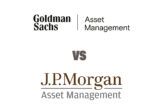Apprehension concerning overall growth prospects has knocked inflation expectations in recent weeks, exacerbated by falling energy prices and disinflation in the eurozone.
Jeffrey believes that the normal level for a UK government bond yield should be more in line with forecasted economic growth, rather than the current level of 2.9%.
“The normal level for a [UK] government bond yield should be close to the expected growth rate in nominal terms,” he explained. “The government’s target for inflation is 2%. We think the sustainable growth rate for the economy is 2.25%, so that suggests that nominal yields should be 4%.
“They’re way out of line for that level, they need to adjust to get closer to that level. They might not get to 4%, maybe 3.5%, but that’s still significantly different from where we are at the moment. That’s an adjustment process that needs to take place at some stage, and it may be a relatively painful process.
He continued: “As far as Japanese and German bond yields are concerned, they are even more out of line and likely to remain out of line for longer because of the underlying growth threats in those economies.”
On the other side of the Atlantic, the Federal Reserve’s decision to end quantitative easing in October appeared to signal the beginning of a period accelerated growth for the US economy.
However, Jeffrey believes that the bond market could suffer from trade activity falling behind the interest rate curve.
“If you take the US market there has to be an increasing risk of market participancy being behind the interest rate curve, and that will scare the bond market,” he said. “Bond markets react better if they think they are getting ahead of the interest rate curve and raise interest rates a little bit earlier, keeping inflation in check.”
Jeffrey continued with an appraisal of the bout of US quantitative easing, saying that it has not had the desired effect on inflation.
“When I was at university we were taught that quantitative easing was an absolute last resort, because people didn’t understand the consequences but they would probably be inflationary,” he recalled.
“We’ve had a huge amount of QE and it doesn’t appear to have been inflationary. There has been just one hint of it being inflationary – it did create some inflation in commodity markets and also created some asset price inflation in bond markets and probably some equity markets.
“So there have been some inflationary consequences but not yet in terms of domestically-generated inflation. QE will become more inflationary the longer that economies continue to grow at a reasonable rate, but I don’t think you can be any more precise than that.”
While QE has contributed to negativity in the bond market, Jeffrey’s view is that with a growing economy there will be better inflation prospects.
“There’s an enormous amount of liquidity that has been locked into the monetary system,” he said. “That is why bond yields have been held down so much. But the more confident that people get about growth in the economy, the more that liquidity will be unlocked and the greater potential it will have to create inflation.”
However, he warned that without preventative measures the bond market could be panicked into a sell-off, though there is no telling when.
“I think bonds could be the most at-risk asset,” he said. “That’s not to say the sell-off is going to happen over the next year, it may not. You can go through long periods where you know something is unsustainable but you can’t tell when it is going to fall over – it was like that with the build-up in debt.
“What you can’t do is predict when it is going to collapse, and I think it is the same with bond markets. You can’t predict that moment when everybody says ‘oh, the emperor has no clothes’. But you can point out fundamental misalignments and it seems to me that bond yields are not aligned with what we expect to happen in the real economies.”
















